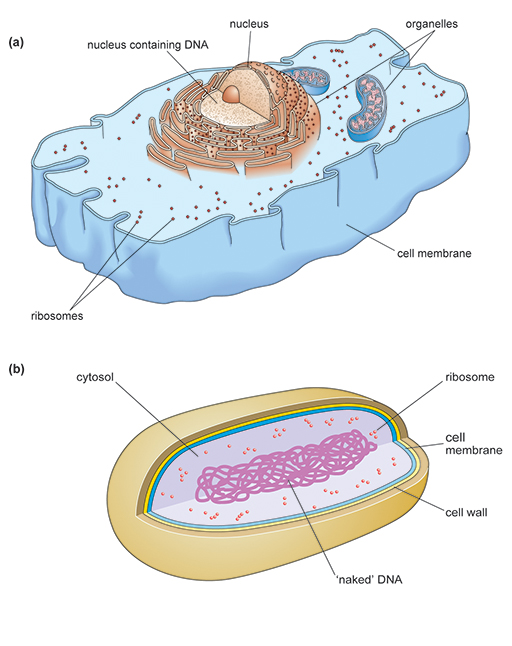1.1 Cell structure
There are two distinct types of cell. Bacteria are
Activity 1 Exploring cell basics
(a) Study the general organisation of prokaryotic and eukaryotic cells in Figure 1. Then read more about each component below.

Cell membrane
A complex structure enclosing the cytosol of living cells which controls the passage of substances into and out of the cell.
Cell wall
A protective outer layer which provides mechanical support to the cell. It also prevents harmful surges of water moving into the cell by osmosis which could cause it to burst (lysis).
Cytosol
A watery fluid in which many chemical reactions take place.
Ribosome
A structure where proteins are made in the cell. Each ribosome consists of a large and a small subunit which have distinct roles in protein synthesis.
Mitochondrion
The place in a cell where chemical energy derived from nutrients is converted to a form that can be used by the cell (plural, mitochondria).
Endoplasmic reticulum
The place in a cell that sorts proteins and ensures they are transported to the correct part of the cell. The rough endoplasmic reticulum is studded with ribosomes.
Nucleus
A membrane-bound structure that encloses the genetic material (DNA).
DNA
Deoxyribonucleic acid is a large molecule containing the cell’s genetic information. This is the complete set of instructions needed for an organism to grow, survive and reproduce.
(b) What structural differences can you see between the bacterial and the animal cell?
Answer
- The bacterial cell has a cell wall; the animal cell lacks one.
- The bacterial cell lacks membrane-bound
organelles such as mitochondria and endoplasmic reticulum. - DNA is free in the cytosol of the bacterial cell; DNA in the animal cell is in the nucleus.
- In the animal cell, ribosomes are both free in the cytosol and attached to the membrane of the rough endoplasmic reticulum.
Although there are similarities between the two cell types, eukaryotic cells are structurally much more complex. Prokaryotes and eukaryotes carry out the same essential processes necessary for survival, such as making new proteins,
Antibiotics are selectively toxic because they target structural features or cellular processes in the bacterial pathogen that are different or lacking in the host’s cells.
